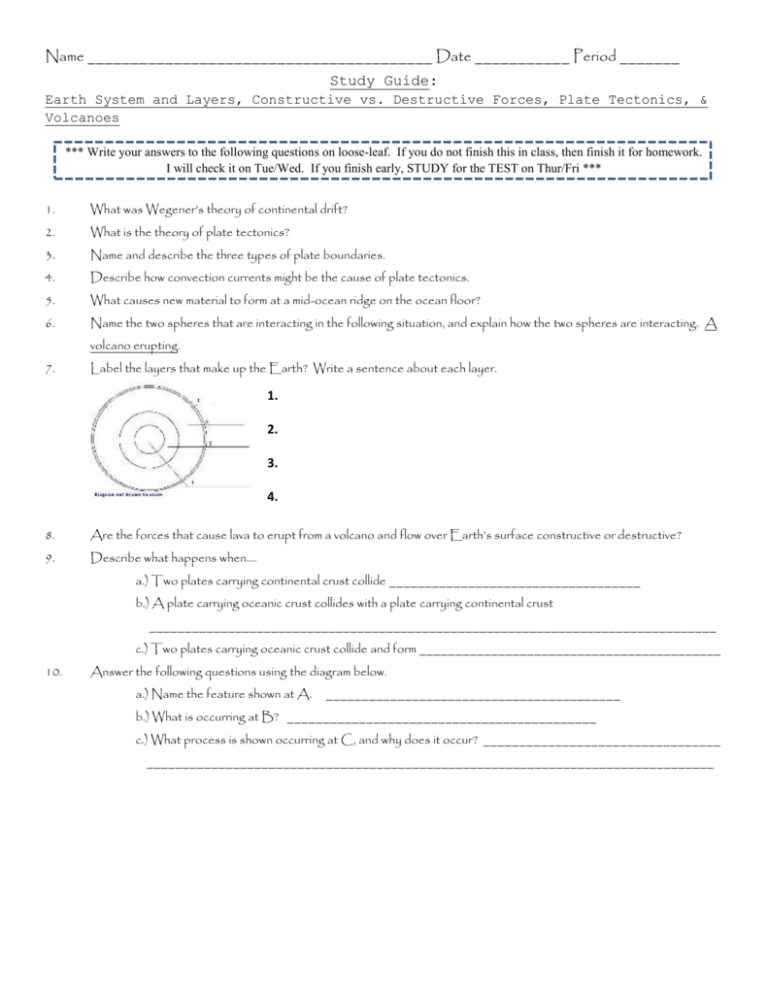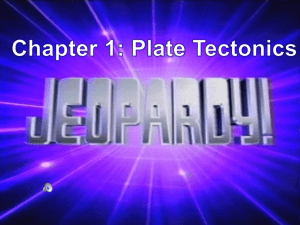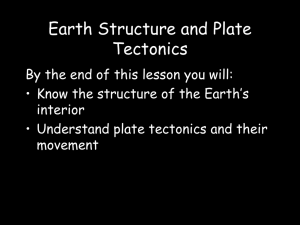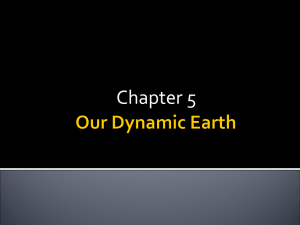1. Crust - Riverdale Middle School
advertisement

Name ________________________________________ Date ___________ Period _______ Study Guide: Earth System and Layers, Constructive vs. Destructive Forces, Plate Tectonics, & Volcanoes *** Write your answers to the following questions on loose-leaf. If you do not finish this in class, then finish it for homework. I will check it on Tue/Wed. If you finish early, STUDY for the TEST on Thur/Fri *** 1. What was Wegener’s theory of continental drift? 2. What is the theory of plate tectonics? 3. Name and describe the three types of plate boundaries. 4. Describe how convection currents might be the cause of plate tectonics. 5. What causes new material to form at a mid-ocean ridge on the ocean floor? 6. Name the two spheres that are interacting in the following situation, and explain how the two spheres are interacting. A volcano erupting. 7. Label the layers that make up the Earth? Write a sentence about each layer. 1. 2. 3. 4. 8. Are the forces that cause lava to erupt from a volcano and flow over Earth’s surface constructive or destructive? 9. Describe what happens when…. a.) Two plates carrying continental crust collide ___________________________________ b.) A plate carrying oceanic crust collides with a plate carrying continental crust _______________________________________________________________________________ c.) Two plates carrying oceanic crust collide and form __________________________________________ 10. Answer the following questions using the diagram below. a.) Name the feature shown at A. _________________________________________ b.) What is occurring at B? ___________________________________________ c.) What process is shown occurring at C, and why does it occur? _________________________________ _______________________________________________________________________________ 11. What accounts for the differences in density between oceanic and continental crust? 12. Draw what scientists believed the Earth and it’s continents looked like 225 million years ago in circle A, and then draw where the continents are located today in circle B. a 13. b Explain what force caused the movement of the continents from one supercontinent to their present position. 14. Explain the theory of sea-floor spreading and draw and label a model to explain what is occurring. 15. What is the difference between magma and lava? 16. What is the Ring of Fire and where is it located? 17. Contrast the silica content of magma in quiet and explosive eruptions. 18. 19. Name and explain the three different types of heat transfer and give an example of each. Where does heat come from that drives the convection currents in the mantle? Where is the temperature of the mantle greater? How do you think the convection currents affected the crust material above it? 20. ANSWER KEY Name ________________________________________ Date ___________ Period _______ Study Guide: Earth System and Layers, Constructive vs. Destructive Forces, Plate Tectonics, & Volcanoes Essay Questions: 1. What was Wegener’s theory of continental drift? Wegener’s theory was that continents originated as the supercontinent, Pangaea, then they moved horizontally to their present location. 2. What is the theory of plate tectonics? The theory states that the Earth’s crust is broken into sections called plates. Convection currents in the mantle is what causes the plates to move around. 3. Name and describe the three types of plate boundaries. a. Divergent- two plates move away from one another b. Convergent- two plates move toward one another c.Transform-fault – two plates slide past one another 4. Describe how convection currents might be the cause of plate tectonics. The cycle of heating, rising, cooling, and sinking of the hot plastic-like rock in the mantle causes the plates on top to move around. 5. What causes new material to form at a mid-ocean ridge on the ocean floor? Hot magma is forced upward at the midocean ridges. Then it turns and flows sideways, carrying the seafloor away from the ridges in both directions. 6. Name the two spheres that are interacting in the following situation, and explain how the two spheres are interacting. A volcano erupting. The rock and lava in the geosphere is erupting into the atmosphere. 7. Label the layers that make up the Earth? Write a sentence about each layer. 1. Crust – solid, rocky outer layer (continental and oceanic crust) 2. Mantle – hot rock, where convection currents occur 3. Outer Core – molten/liquid metal 8. Are the forces that cause lava to erupt from a volcano and flow over Earth’s surface constructive or destructive? The forces can be both constructive and destructive. When the lava flows over the Earth’s surface it kills and destroys things like plants and animals. This is destructive. When the lava hardens and turns into rock adding to the Earth’s surface, this is constructive. 9. Describe what happens when…. a.) Two plates carrying continental crust collide forming mountains b.) A plate carrying oceanic crust collides with a plate carrying continental crust subduction occurs; the oceanic plate goes under the continental plate c.) Two plates carrying oceanic crust collide and form trenches and volcanoes 10. Answer the following questions using the diagram below. a.) Name the feature shown at A. Mid-Ocean Ridge b.) What is occurring at B? Sea-floor spreading c.) What process is shown occurring at C, and why does it occur? Subduction, because the ocean floor is so much heavier (denser) than the land 11. What accounts for the differences in density between oceanic and continental crust? Oceanic crust is made mostly of basalt, a dense rock. Continental crust is made mostly of granite, which is less dense. 12. Draw what scientists believed the Earth and it’s continents looked like 225 million years ago in circle A, and then draw where the continents are located today in circle B. A B 13. Explain what force caused the movement of the continents from one supercontinent to their present position. The convection currents in the mantle caused the crust on top to break apart and drift in different directions. 14. Explain the theory of sea-floor spreading and draw and label a model to explain what is occurring. Sea-floor spreading adds more crust to the ocean floor. At the same time, older strips of rock move outward from either side of the ridge. 15. What is the difference between magma and lava? Magma is melted rock found below Earth’s surface and lava is melted rock found at the Earth’s surface. 16. What is the Ring of Fire and where is it located? The Ring of Fire is one major belt of volcanoes that rim the Pacific Ocean. 17. Contrast the silica content of magma in quiet and explosive eruptions. The magma in a quiet eruption is low in silica. The magma of an explosive eruption is high in silica. 18. Textbook pg. 178 19. Name and explain the three different types of heat transfer and give an example of each. Radiation – transfer of heat through rays or waves Ex: sunburn Conduction – transfer of heat through touch Ex: using a heating pad Convection – flow of material Ex: boiling water 20. Where does heat come from that drives the convection currents in the mantle? The core Where is the temperature of the mantle greater? Closer to the core How do you think the convection currents affected the crust material above it? It caused the crust to break apart and move around








